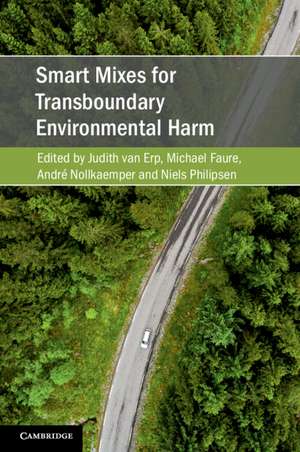Smart Mixes for Transboundary Environmental Harm: Cambridge Studies on Environment, Energy and Natural Resources Governance
Editat de Judith van Erp, Michael Faure, André Nollkaemper, Niels Philipsenen Limba Engleză Paperback – 18 mai 2022
| Toate formatele și edițiile | Preț | Express |
|---|---|---|
| Paperback (1) | 271.59 lei 6-8 săpt. | |
| Cambridge University Press – 18 mai 2022 | 271.59 lei 6-8 săpt. | |
| Hardback (1) | 795.26 lei 6-8 săpt. | |
| Cambridge University Press – 27 mar 2019 | 795.26 lei 6-8 săpt. |
Preț: 271.59 lei
Nou
Puncte Express: 407
Preț estimativ în valută:
51.97€ • 54.65$ • 42.94£
51.97€ • 54.65$ • 42.94£
Carte tipărită la comandă
Livrare economică 16-30 aprilie
Preluare comenzi: 021 569.72.76
Specificații
ISBN-13: 9781108449526
ISBN-10: 1108449522
Pagini: 365
Ilustrații: 11 b/w illus. 8 tables
Dimensiuni: 152 x 229 x 19 mm
Greutate: 0.49 kg
Ediția:New ed
Editura: Cambridge University Press
Colecția Cambridge University Press
Seria Cambridge Studies on Environment, Energy and Natural Resources Governance
Locul publicării:New York, United States
ISBN-10: 1108449522
Pagini: 365
Ilustrații: 11 b/w illus. 8 tables
Dimensiuni: 152 x 229 x 19 mm
Greutate: 0.49 kg
Ediția:New ed
Editura: Cambridge University Press
Colecția Cambridge University Press
Seria Cambridge Studies on Environment, Energy and Natural Resources Governance
Locul publicării:New York, United States
Cuprins
List of figures; List of tables; List of contributors; Preface; List of abbreviations; Part I. Conceptual Approaches to Smart Mixes: 1. Introduction: the concept of smart mixes for transboundary environmental harm Judith van Erp, Michael Faure, André Nollkaemper, Niels Philipsen, Jing Liu and Markos Karavias; 2. 'Smart' public-private complementarities in the transnational regulatory and enforcement space Linda Senden; 3. Smart mixes and the challenge of complexity: lessons from global climate governance Philipp Pattberg and Oscar Widerberg; 4. Smart (and not so smart) mixes of new environmental policy instruments Rüdiger Wurzel, Anthony Zito and Andrew Jordan; Part II. Fisheries and Forestry: 5. The pursuit of good regulatory design principles in international fisheries law: what possibility of smarter international regulation? Richard Barnes; 6. Mixing regional fisheries management and private certification Markos Karavias; 7. RFMO-MSC smart regulatory mixes for transboundary tuna fisheries Agnes Yeeting and Simon R. Bush; 8. Smart mixes in forest governance Jing Liu; 9. Governing forest supply chains: ratcheting up or squeezing out? Constance McDermott; 10. Public sector engagement with private governance programs: interactions and evolutionary effects in forest and fisheries certification Lars Gulbrandsen; Part III. Climate Change and Oil: 11. Smart mixes, non-state governance and climate change Neil Gunningham; 12. Private control of public regulation: a smart mix? The case of greenhouse gas emission reductions in the EU Marjan Peeters and Mathias Muller; 13. Smart mixes with respect to civil liability regimes for marine oil pollution Michael Faure and Hui Wang; 14. Regulatory mixes in governance arrangements in (offshore) oil production: are they smart? Jan van Tatenhove; Part IV. Concluding Remarks: 15. Conclusion: smart mixes in relation to transboundary environmental harm Judith van Erp, Michael Faure, André Nollkaemper and Niels Philipsen.
Descriere
Analyzes how combinations of instruments at different levels of government, or smart mixes, can effectively regulate transboundary environmental harm.














